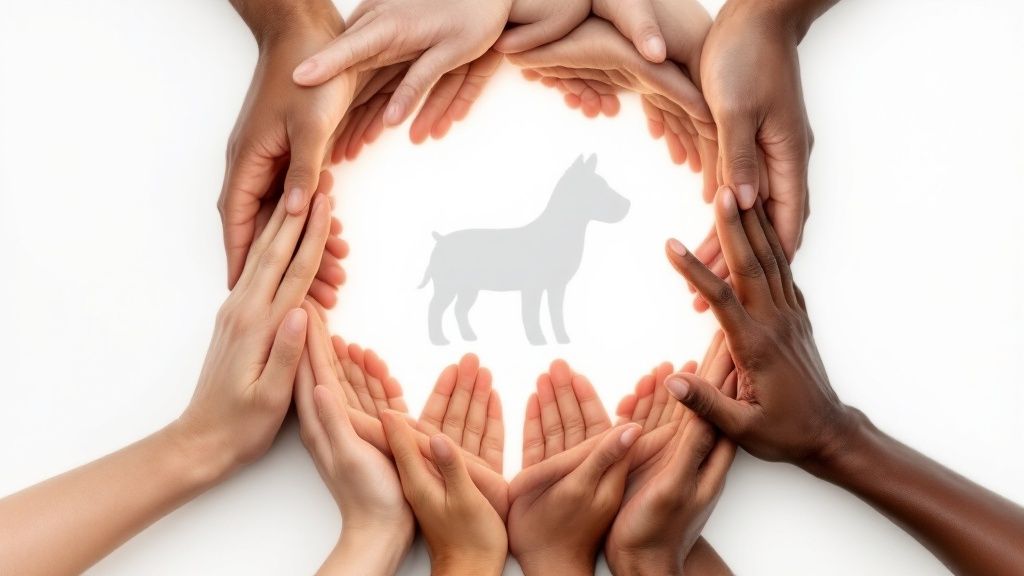Animal Cruelty Laws: Strong Steps for Protection
- f85661678
- 12 minutes ago
- 15 min read
The Evolution of Animal Cruelty Laws: From Property to Protection
Historically, animals were considered mere property. Laws focused on protecting their economic value to owners, not their well-being. Harming an animal was only a crime if it infringed upon someone's property rights. Damaging a farmer's livestock, for instance, was illegal, but the animal's suffering was legally irrelevant. This perspective began to change with the rise of animal welfare movements in the 19th century.
Driven by compassionate individuals concerned about working animals, these early movements led to the first anti-cruelty laws. Initially, these laws focused on preventing overt acts of violence and neglect. They also laid the foundation for understanding animals as beings capable of suffering. This growing recognition of animal sentience was a pivotal moment in the evolution of animal cruelty laws.
The Rise of Animal Sentience and Modern Legislation
The concept of animal sentience—the capacity of animals to experience feelings—plays an increasingly important role in modern animal cruelty legislation. Acknowledging that animals can experience positive and negative emotions is slowly being integrated into legal frameworks, driving advancements in animal welfare laws globally. However, the degree of recognition and its enforcement varies greatly.
The effectiveness of these laws differs significantly between countries. As of November 2019, 32 countries, including Austria, Australia, and the United Kingdom, formally recognized non-human animal sentience. This recognition can lead to stronger animal welfare laws and better enforcement. Learn more about animal rights by country on Wikipedia.
Many nations, however, still lack comprehensive anti-cruelty laws, leading to widespread animal abuse. Even where laws exist, they often rely on public reporting and might not address all forms of cruelty, such as those found in industrial agriculture or entertainment. Despite the challenges, recognizing animal sentience is a crucial step towards improving global animal welfare standards.
Before we delve further into the challenges and opportunities, let's examine a timeline of significant legal developments:
The following table outlines key milestones in animal cruelty legislation:
Year/Period | Country/Region | Legal Development | Significance |
|---|---|---|---|
1822 | United Kingdom | Cruel Treatment of Cattle Act | First legislation specifically addressing animal cruelty. |
1866 | United States | ASPCA founded | Led to increased awareness and advocacy for animal welfare. |
1976 | United Kingdom | Animal Welfare Act | Introduced stricter penalties for animal cruelty. |
2002 | Germany | Animal welfare enshrined in the constitution | Elevated the legal status of animal protection. |
2019 | Various countries (32 total) | Formal recognition of non-human animal sentience | Promotes stronger animal welfare laws and better enforcement. |
This table shows the progress made in recognizing and protecting animal rights, though much work remains to be done globally.
Challenges and Opportunities in Enforcement
Even with robust laws, enforcement poses a significant challenge. Limited resources, varying interpretations of the law, and the difficulty of proving intent can hinder prosecutions. A neglect case, for example, can be difficult to prosecute if an owner claims ignorance or inability to provide proper care. This underscores the need for clear legal definitions and adequate training for law enforcement and animal control officers.
Despite these challenges, promising developments are emerging. Technology, including video evidence and online reporting platforms, is making it easier to document and track animal cruelty. This increased accountability can drive both individual and systemic change. Public awareness campaigns and educational initiatives are also essential for fostering respect and compassion towards animals, ultimately leading to better enforcement and more effective protection.

Decoding Protection: What Animal Cruelty Laws Actually Cover
Animal cruelty laws aim to shield animals from harm, but they often create a confusing array of protections. These laws aren't universally applied, leading to inconsistencies in how different species are treated. This raises a crucial question: why is a dog afforded more legal protection than a pig, an animal of comparable intelligence?
Varied Protections Across Species
Several factors contribute to these discrepancies, including historical context, cultural norms, and economic considerations. Historically, animal protection laws emphasized their value as property, not their inherent right to a life free from suffering. This legacy still shapes modern law. For example, farm animals often receive less protection due to the agricultural industry's economic influence. Laws frequently exempt standard farming practices, even those known to inflict substantial suffering. This reveals a significant disconnect between public perception of animal welfare and legal realities.
Cultural practices further complicate matters. Acceptable animal treatment varies drastically across cultures, creating tension between universal welfare standards and respect for traditions. The challenge is finding a balance. Where do we differentiate necessary practice from needless suffering, especially when economic interests are at stake?
Understanding Legal Cruelty
Defining legal cruelty is crucial. While blatant acts of violence are typically prohibited, the nuances of neglect, abuse, and exploitation are often murky. Neglect, for instance, can be difficult to define and prosecute, often requiring proof of intent or extreme negligence. This proves challenging, especially when owners claim ignorance or inability to provide proper care.
The Role of Public Perception and Advocacy
Public opinion significantly shapes legislation and enforcement. Increased awareness of animal sentience, the capacity to feel emotions, influences legal frameworks globally. Advocates leverage sentience research to push for stronger protections. Stories of individual animal suffering, like Cheyenne the shepherd who was shot, deeply affect public sentiment and can ignite change. Yet, as the Michael Vick case demonstrated, even high-profile abuse cases highlight the complex issues of rehabilitation and the debate surrounding appropriate penalties for cruelty.
Ultimately, grasping the complexities of animal cruelty laws requires a nuanced perspective, acknowledging historical, cultural, and economic influences. It also demands continuous public involvement and advocacy to ensure these laws genuinely protect animals from unnecessary suffering and safeguard their well-being.
Beyond Paper Promises: How Animal Cruelty Laws Actually Work

Strong animal cruelty laws are vital, but they're only as good as their enforcement. This is where theory translates into practice, and sadly, the journey from reported cruelty to actual justice can be long and difficult. This means animals may suffer even where laws appear comprehensive. This section explores the realities of enforcement, highlighting both challenges and successful strategies.
The Challenges of Enforcement
A major obstacle is limited resources. Animal control agencies are often understaffed and underfunded, struggling to handle the sheer number of cruelty reports. This leads to investigation delays, prolonging animal suffering. Inadequate training for law enforcement and animal control officers also hinders effective investigations and prosecutions.
Jurisdictional conflicts add another layer of complexity. Disputes between local, state, and federal agencies over authority can lead to inaction. Cases involving interstate animal transport or animal fighting rings, for instance, can fall into legal gray areas, obstructing effective prosecution. This creates protection deserts, leaving animals vulnerable despite legislation. Globally, animal abuse is widespread and underreported. In the United States alone, an estimated ten million animals die from abuse each year.
Only a small fraction of cases are reported, due to a lack of comprehensive reporting systems. This underscores the need for better laws and enforcement globally. Countries with stronger animal welfare rules, such as some European nations, often have better outcomes. The disparity between regions highlights the urgent need for global standards and greater awareness of animal cruelty. More detailed statistics can be found here.
From Report to Prosecution: A Difficult Path
The process after a cruelty report is often complex. An officer must investigate, gather evidence, and interview witnesses. If there's enough evidence, charges are filed. However, many cases never make it to prosecution due to lack of evidence, jurisdictional problems, or limited resources.
Even when cases do proceed, penalties are often too lenient to deter further abuse. Small fines and short jail sentences may not reflect the crime's severity. This perpetuates a cycle of abuse, especially in cases like hoarding or organized animal fighting.
Innovative Approaches to Enforcement
Despite the challenges, promising approaches are emerging. Some areas are establishing specialized animal cruelty units within law enforcement, dedicating resources and expertise. Others collaborate with animal welfare organizations, leveraging their knowledge and resources. Some shelters, for example, train law enforcement on animal behavior and handling, improving investigation effectiveness.
Technology is also crucial. Digital evidence, such as photos and videos, strengthens cases. Online reporting platforms make it easier for the public to report suspected cruelty. These advances improve accountability and lead to more successful prosecutions. Some agencies use data analysis to identify abuse patterns, enabling proactive interventions and prevention. These strategies offer promising paths toward better animal protection, demonstrating how strong laws, combined with dedicated resources and innovation, can make a real difference. These examples could serve as models for improving animal welfare across different regions.
Global Protection: Where Animal Cruelty Laws Lead or Lag
Animal cruelty laws vary significantly across the globe. Some nations have established comprehensive legal frameworks, while others provide only minimal protection. This global disparity reflects differing cultural values, economic priorities, and political landscapes. Understanding these differences is essential to promoting animal welfare worldwide. Identifying best practices and areas for improvement is key to progress.
Cultural Influences and Economic Factors
Cultural values play a significant role in shaping animal welfare legislation. In certain cultures, specific animals hold religious significance, resulting in unique legal protections. In other cultures, animals may be viewed primarily as resources, leading to weaker legal protections. For instance, the legal status of dogs differs considerably worldwide, reflecting these diverse cultural perspectives.
Economic factors also influence animal welfare laws. Developed countries often have more resources to allocate to animal welfare initiatives, such as enforcement and public awareness campaigns. However, economic interests, especially in industries like agriculture, can present challenges to implementing stronger protections. This creates a complex interplay between animal welfare and economic considerations.
Model Legislation: Learning from Leaders
Analyzing legislation from countries with robust animal protection systems provides valuable insights for improving legal frameworks worldwide. These models often incorporate the recognition of animal sentience, acknowledging an animal's capacity to feel pain and pleasure. This recognition can lead to stricter penalties for acts of animal abuse and neglect.
Model laws frequently address specific forms of cruelty, particularly those prevalent in factory farming, animal testing, and the entertainment industry. For example, some countries have banned certain farming practices known to cause significant animal suffering. These progressive measures demonstrate how legislation can effectively safeguard animal well-being.
Furthermore, robust animal cruelty laws often include provisions for animal rescue and rehabilitation. This ensures that confiscated animals receive appropriate care and, whenever feasible, are placed in loving homes. This comprehensive approach emphasizes the importance of protecting animals at all stages.
The Voiceless Animal Cruelty Index (VACI) and the Animal Protection Index (API) offer valuable metrics for evaluating animal welfare globally. The VACI focuses on countries accounting for 80% of the world’s farmed animals, assessing cruelty across production, consumption, and legal sanctions. Countries like India and Kenya often receive high rankings due to lower per-capita meat consumption and less intensive farming practices. Conversely, countries like the United States and Australia tend to rank lower due to their large-scale animal agriculture industries. These indices highlight the multifaceted nature of animal welfare and how legal frameworks, consumption habits, and production methods impact cruelty levels. Learn more about these rankings here.
To better understand global variations in animal protection, consider the following table:
Global Animal Protection Index Comparison
Comparison of animal welfare standards and legal protections across major countries based on established indices
Country | Overall Ranking | Legal Framework | Enforcement Effectiveness | Recognition of Sentience | Notable Strengths/Weaknesses |
|---|---|---|---|---|---|
(Example - High Ranking Country) | (e.g., Top 10) | Comprehensive legislation covering various forms of cruelty | Strong enforcement mechanisms and penalties | Explicitly recognized in law | Strong public awareness and advocacy for animal rights |
(Example - Mid-Ranking Country) | (e.g., Mid-range) | Moderate legal framework with some gaps in protection | Moderate enforcement, inconsistent application of penalties | Implicitly recognized or under debate | Growing public concern for animal welfare, but challenges in implementation remain |
(Example - Low-Ranking Country) | (e.g., Bottom Tier) | Limited legal framework, minimal protections | Weak enforcement, lenient penalties | Not recognized in law | Limited public awareness and resources for animal welfare |
Note: This table provides a simplified illustration. Actual rankings and assessments would involve detailed analysis based on specific indices like VACI and API.
This table demonstrates the variations in animal welfare standards across different countries. It highlights the importance of analyzing not just the presence of laws, but also their enforcement and the cultural context in which they operate.
International Agreements and Harmonizing Standards
International agreements are playing an increasingly vital role in harmonizing animal welfare standards globally. These agreements encourage nations with less developed laws to strengthen their protections. However, implementing and enforcing these agreements can be complex, requiring international cooperation and unwavering commitment.
Political Priorities and Public Awareness
Political will is essential for enacting and enforcing strong animal cruelty laws. Public awareness and advocacy are critical for influencing political agendas. Increased public pressure often leads to stronger legislation and more effective enforcement. Educating the public about animal welfare issues is therefore paramount for driving positive legal change. This empowers individuals to demand action from their governments, ultimately contributing to a more compassionate world for animals.
When Animals Feel: How Sentience Is Reshaping Legal Protection

The scientific understanding of animal sentience is constantly evolving. Research shows that animals experience a wide spectrum of emotions, from joy and excitement to fear and pain. This growing body of knowledge is beginning to have a significant impact on animal cruelty laws around the world.
This means the legal landscape concerning animal protection is undergoing a transformation, influenced by these new scientific discoveries. This section explores how the recognition of sentience is prompting legal reform and challenging existing legal frameworks.
The Growing Recognition of Sentience in Law
Several countries are leading the charge in incorporating animal sentience into their legal systems. Some European nations, for instance, now explicitly recognize animal sentience within their animal welfare legislation. This provides a much stronger basis for animal protection. It moves beyond simply preventing physical harm to also considering an animal's emotional well-being.
This shift has far-reaching implications for various practices involving animals, including farming, research, and other areas where animals are used by humans. The very definition of "humane treatment" is being redefined to encompass not just physical needs but also emotional ones.
The practical impact of recognizing sentience is evident in the changes to specific practices. Some countries are restricting or phasing out certain farming practices known to cause significant emotional distress, even in the absence of physical harm. This shows how legal frameworks are adapting to reflect the evolving scientific understanding of animal sentience. However, it's important to note that progress remains uneven across different countries and species.
Species Distinctions and the Shared Capacity for Suffering
Despite the growing recognition of sentience, many legal systems still draw arbitrary distinctions between species. This results in some animals, such as dogs and cats, receiving greater legal protection than others, like farm animals, despite evidence suggesting a similar capacity for suffering across many species.
This disconnect between scientific understanding and legal protection creates inconsistencies and significant challenges for animal welfare advocates. For example, a dog might be protected from certain types of harsh training. Meanwhile, a pig might be subjected to similar treatment within intensive farming systems, even if both animals experience comparable levels of distress.
This highlights a crucial need: laws must align better with scientific evidence and apply protections more consistently across different species. This ethical dilemma becomes even more apparent when considering animals used in research or the entertainment industry. Primates used in research, for example, may possess higher cognitive abilities than some companion animals, yet their legal protections often differ significantly. These contradictions highlight the complex nature of applying sentience-based legal protections.
Advocating for Change: Sentience Research and Legal Reform
Animal welfare advocates are actively using sentience research to push for meaningful legal reforms. They argue that current laws often lag behind the scientific understanding of animal consciousness and emotions. The work of researchers documenting animal emotions and cognitive abilities is playing an increasingly important role in shaping legal discussions.
The concept of "personhood" for certain animal species is gaining traction among some animal rights groups. This aims to grant legal rights and protections similar to those enjoyed by humans to certain animals, primarily those with demonstrated high cognitive abilities. These animals would then be considered legal persons, not property. While still a developing concept, this represents a significant shift in thinking about animal rights.
Animal cruelty laws are not static; they are constantly evolving. The increasing recognition of animal sentience is a key driver behind ongoing legal and social change. As our understanding of animal consciousness deepens, the pressure for stronger and more ethical protections will undoubtedly intensify. The future of animal welfare hinges on continued debate and adjustments to legal frameworks, constantly grappling with the question of how to best balance human interests with the ethical considerations arising from this increasing recognition of animal sentience.
Industry Immunity: When Animal Cruelty Laws Don't Apply
Despite growing public awareness and support for animal welfare, numerous industries operate under exemptions to animal cruelty laws. These exemptions present a complicated ethical dilemma, forcing us to examine the balance between economic interests and animal protection. This section explores these exemptions across various sectors, highlighting the resulting discrepancies in how animals are protected.
The Discrepancy Between Pets and Production Animals
Perhaps the most significant contrast in legal protection lies between companion animals, like cats and dogs, and animals raised for food production. While laws prohibiting outright cruelty exist for all animals in most jurisdictions, the standards for farm animals are frequently far lower. Routine practices on factory farms, such as intensive confinement and certain mutilations performed without anesthesia, are often specifically excluded from general animal cruelty laws. This creates a two-tiered system where actions deemed illegal if inflicted on a pet are perfectly acceptable when done to animals like pigs, cows, or chickens raised for food.
This double standard originates largely from the considerable influence of the agricultural industry. Economic pressures often take precedence over concerns for animal suffering. The result is a legal system where the economic value of animals used for food trumps their right to a life free from unnecessary pain and distress. High-profile cases of companion animal cruelty spark public outcry and demands for justice. Yet, comparable suffering endured by farm animals often remains legally permitted and largely hidden from the public eye.
Research and Entertainment: Further Legal Gray Areas
Similar exemptions frequently apply to animals used in scientific research and the entertainment industry. While regulations exist for the treatment of animals in these sectors, they commonly permit procedures that would be considered cruel under standard animal cruelty laws. In medical research, for example, animals might be subjected to painful experiments or euthanized after testing, procedures generally not allowed for companion animals.
The entertainment industry presents its own unique challenges. While extreme cases of animal cruelty, such as dogfighting, capture headlines and lead to prosecution, many other forms of animal exploitation in entertainment exist in a legal gray area. This includes specific training methods employed in circuses or film production that could be considered inhumane if applied to pets.
Reform Efforts: Filling Protection Gaps
Acknowledging these inconsistencies, some industries are taking steps to improve animal welfare through voluntary guidelines and certification programs. Certain agricultural operations, for instance, are adopting “humane” certifications to assure consumers their animals are raised according to specific welfare standards that exceed the minimum legal requirements. Likewise, some research institutions are implementing internal animal care policies that go beyond what the law requires. These efforts indicate a growing recognition of animal welfare issues, but they also raise questions about the effectiveness and enforcement of voluntary standards.
These voluntary initiatives, while positive developments, often lack the accountability and enforcement mechanisms of formal legal frameworks. They can also lead to consumer confusion, as differentiating genuine welfare improvements from simple marketing tactics becomes difficult. This underscores the continuing need for stronger legal protections and consistent enforcement to ensure meaningful and uniform animal welfare standards across all industries.
The Path Forward: Balancing Competing Interests
The issue of industry exemptions to animal cruelty laws reveals a complex interplay between economic interests, societal values, and animal well-being. Addressing this requires a thoughtful and balanced approach. While respecting the economic contributions of these industries, it's crucial to ensure that animal welfare isn't unjustly compromised for the sake of profit. This means strengthening current laws, eliminating loopholes, and improving enforcement. Ultimately, it demands a shift in how society perceives and values animals, irrespective of their economic utility. This cultural evolution must be fueled by heightened public awareness, ongoing advocacy efforts, and a commitment to bringing legal frameworks into alignment with our evolving ethical understanding of how we treat animals.
The Future of Animal Cruelty Laws: Promising Paths Forward

Animal protection is a constantly evolving field. This naturally leads us to consider the future of animal cruelty laws. This section explores emerging trends and promising developments that could reshape how we legally protect animals, offering hope for more comprehensive and effective animal welfare in the years to come.
Technology's Role in Documentation and Enforcement
Technology is playing a key role in how we document and enforce animal cruelty laws. The widespread availability of video recording on smartphones, for instance, makes it easier than ever to capture evidence of abuse. This accessibility empowers witnesses and increases accountability for perpetrators.
Online platforms and databases also contribute to more efficient reporting mechanisms. These digital tools streamline communication between the public and law enforcement agencies, potentially expediting responses and investigations. These advancements provide powerful tools for both preventing and prosecuting animal cruelty.
Shifting Public Attitudes and Legislative Momentum
Changing public attitudes toward animals are driving legislative change. A growing awareness of animal sentience and the capacity of animals to experience a range of emotions is fueling demands for stronger legal protections. Several countries have already incorporated sentience into their animal welfare laws, recognizing animals as beings capable of suffering.
This increased awareness translates into stronger public support for animal protection policies. Politicians are increasingly recognizing the importance of these concerns, which could lead to more robust legislation and better funding for enforcement.
Unexpected Allies: Climate Policy and Public Health
The movement for stronger animal protection is gaining support from unexpected sources. Climate policy, sustainability initiatives, and public health programs are increasingly acknowledging the interconnectedness of human, animal, and environmental well-being.
For example, the promotion of plant-based diets for environmental reasons can also reduce the demand for animal agriculture, thus lessening the suffering of animals raised for food. Similarly, addressing zoonotic diseases—diseases that can spread between animals and humans—through improved animal welfare practices benefits both animals and people. This convergence of interests has the potential to significantly advance animal protection.
Identifying Promising Legal Models
As animal cruelty laws evolve, identifying and replicating successful legal models becomes crucial. Some countries are establishing specialized animal cruelty courts with expertise in animal law and welfare, leading to more informed decisions. Other regions are implementing innovative rehabilitation programs for offenders to address the root causes of abuse.
These legal frameworks offer the potential for significantly improving animal protection outcomes. They serve as valuable examples for other jurisdictions seeking to strengthen their own animal welfare laws.
The fight against animal cruelty is ongoing. However, the combination of technological advancements, evolving public attitudes, alliances with related movements, and the development of effective legal models creates significant momentum for positive change. By learning from past successes, embracing innovation, and maintaining public pressure, we can strive for a future where animal cruelty is not only illegal but also unthinkable.
Want to take action? The U.S. Animal Abuse Registry (https://www.usaar.org) provides resources and information on protecting animals in your community. Learn about offenders, report abuse, and support their fight against animal cruelty.
Comments